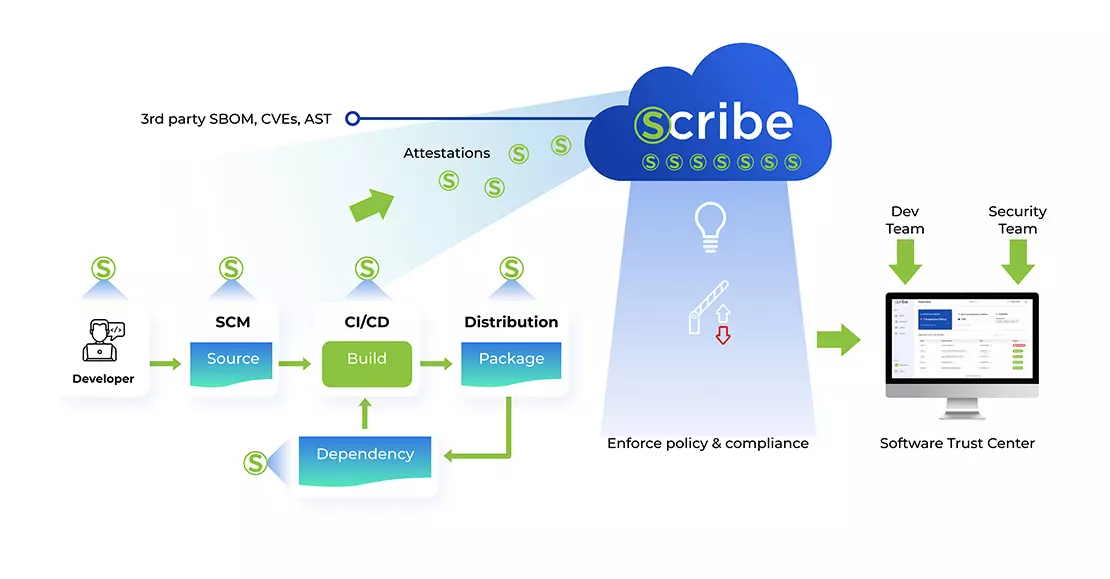Scribe vs. Traditional SCA
Is SCA enough to protect software supply chain security?
Software Composition Analysis (SCA) tools primarily address a limited application security scope, focusing on vulnerabilities and licensing in open-source dependencies. While effective for managing specific risks, SCAs only solve part of the software supply chain and application security challenge. Scribe Security, by contrast, provides a comprehensive software supply chain security (SSCS) platform that combines multiple tools, including SCA, with a full suite of capabilities for SBOM management, SDLC governance, and end-to-end SSCS. This empowers DevSecOps and product security teams to address their complete security challenges far beyond what SCA tools alone can offer.
Scribe’s Enhanced SCA Capabilities Compared to Traditional SCA Tools
| Feature / Aspect | Scribe Security | Typical SCA | Comparison |
| End-to-End Software Supply Chain Security | Scribe provides comprehensive security coverage across the SDLC, securing everything from code integrity and provenance to build systems, pipelines, and final deployment. | SCAs focus primarily on managing open-source dependencies, lacking coverage of the broader supply chain, including CI/CD pipelines and SDLC stages. | Advantage: Scribe’s full SDLC security coverage extends beyond dependency analysis to protect the entire software supply chain. |
| Advanced SBOM Management with Fusion and Dossier Creation | Scribe generates, signs, and fuses SBOMs from different SDLC stages (e.g., Git, build checkout, final image), creating a product-aware SBOM inventory that maintains a detailed dossier for each release. Scribe also ingests third-party SBOMs and continuously tracks vulnerabilities. | SCAs focus on vulnerability identification during development and do not track products after release. If an SCA vendor offers generating SBOMs, they are usually static snapshots without fusion, inventory management, or release-specific tracking. | Advantage: Scribe’s advanced SBOM management ensures accurate, real-time SBOM data that supports full lifecycle compliance and visibility. |
| Automated Compliance with SSC Standards | Scribe automates workflows for complex standards such as SLSA, SSDF, and EO 14028, integrating compliance requirements seamlessly into CI/CD processes. | SCAs may assist with basic license compliance but generally lack support for SSC standards and automated compliance workflows. | Advantage: Scribe’s compliance automation aligns with evolving standards, reducing manual effort for regulatory adherence. |
| Flexible Policy Gates Across the SDLC | Scribe’s policy gates can be enforced at various critical points in the SDLC, including dev phases, build, admission control, and post-deployment. This allows real-time blocking and mitigation in multiple locations based on accumulated evidence. | SCAs are generally limited to stopping a build and informing the developer about vulnerabilities without additional policy enforcement locations. | Advantage: Scribe’s flexible policy gates support a more proactive security approach, providing security enforcement options across the SDLC. |
| Vulnerability and Risk Management with VEX Advisory Management and | Scribe identifies dependencies and associated vulnerabilities. Its VEX (Vulnerability Exploitability eXchange) advisory management enables context-aware advisories to be shared with the consumers of the released software. Scribe tracks new vulnerability publications post-release by comparing them to its SBOM inventory and notifying stakeholders. | SCAs focus on vulnerability identification but don’t generally cater to the use case of sharing risk information from the software producer to the software consumers, | Advantage: Leveraging its SBOM inventory capability, which SCA vendors don’t typically offer, Scribe emphasizes the role of risk management post-release through managing and sharing advisories and new vulnerability alerts with stakeholders |
| Transparency and Communication of Release Security | Scribe allows software producers to communicate detailed, verifiable transparency data about each release to software consumers, meeting compliance and customer trust needs. | SCAs do not typically offer transparency or trust mechanisms to provide security assurances to end-users. | Advantage: Scribe’s transparency framework supports verifiable trust, providing consumers with secure release documentation that meets standards like SLSA and SSDF. |
| Integrated ASPM Features for Holistic Security | Scribe integrates Application Security Posture Management (ASPM) capabilities, unifying outputs from over 140 security tools into a consolidated view of security posture. | SCAs specialize in dependency and vulnerability management without ASPM capabilities or broad integration with security tools. | Advantage: Scribe’s ASPM integration delivers centralized visibility, providing comprehensive security management across all tool outputs. |
| Anti-Tampering Controls and Code Signing | Scribe includes anti-tampering protections, automated code signing, and attestation to safeguard software integrity from development through deployment. | SCAs generally do not include tamper-proofing or code signing, focusing solely on vulnerability detection. | Advantage: Scribe’s anti-tampering and signing features ensure software integrity and provenance, securing the full SDLC. |
| Supply Chain-Wide Asset Discovery and Monitoring | Scribe continuously discovers and monitors assets across the software factory, mapping dependencies, configurations, and lineage from source code to production. | SCAs focus on application-level dependencies, lacking supply chain-wide discovery or monitoring of broader SDLC assets. | Advantage: Scribe’s continuous discovery covers the entire software factory, offering unparalleled visibility and monitoring. |
| Advanced Analytics and Performance KPIs | Scribe’s analytics engine provides deep, customizable insights into software risks and tracks security KPIs to gauge DevSecOps performance on security controls across the SDLC. | SCAs typically provide only vulnerability reports and do not track broader DevSecOps or SDLC-wide security performance KPIs. | Advantage: Scribe’s advanced analytics and performance KPIs provide actionable insights, supporting continuous improvement in security posture across the software supply chain. |

While SCAs primarily address open-source dependency vulnerabilities and licensing risks within applications, Scribe Security offers a full-spectrum software supply chain security solution. Scribe integrates the advantages of SCA—including vulnerability tracking, composition analysis, and ingestion of 3rd party SCA scans– with comprehensive SSCS capabilities such as SBOM, automated compliance, ASPM integration, real-time SDLC governance, and flexible policy gates that can enforce security policies at multiple points in the SDLC, including admission control. Additionally, Scribe’s VEX advisory management, transparency features, and performance KPIs provide security and compliance insights that empower DevSecOps and product security teams to address the entire scope of SSCS. This makes Scribe Security an ideal choice for organizations that require robust, end-to-end software supply chain protection and continuous security measurement, not just dependency management.
